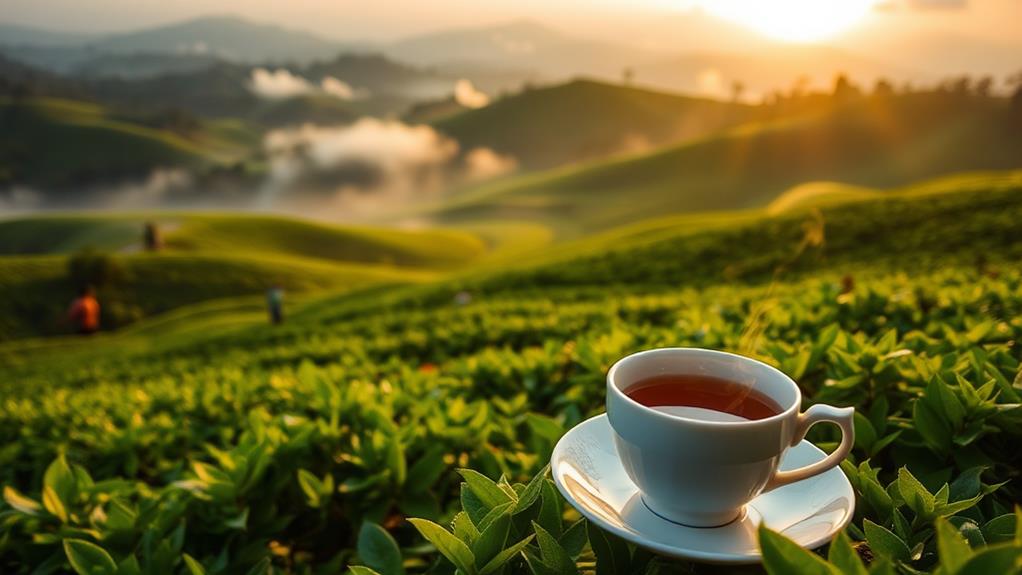Ceylon tea, originating from Sri Lanka, is more than just a drink; it's a cultural treasure. First introduced by British planters in the 19th century, this tea grows in cool highlands, creating unique flavors that include citrusy notes from Dimbulla and floral hints from Nuwara Eliya. Each leaf is carefully hand-picked at the right moment to guarantee quality. Brewing a cup is simple but requires attention to detail, like using the right water temperature. This tea isn't just about taste; it represents Sri Lanka's hospitality and heritage. If you want to explore its health benefits and pairing suggestions, there's much more to uncover!
The Origins of Ceylon Tea
Have you ever wondered where Ceylon tea comes from? This delightful beverage hails from Sri Lanka, formerly known as Ceylon. The island's unique climate, with its cool highlands and rich soil, creates the perfect environment for growing tea.
In fact, the region is renowned for its high-quality Ceylon tea varieties, which are celebrated for their distinct flavors and aromas. In the 19th century, British planters introduced tea cultivation, transforming the landscape and economy of the region. You might be amazed to learn that the first tea plants were brought over from China and India!
Today, Ceylon tea is grown in several regions, each contributing distinct characteristics to the leaves. From the lush hills of Nuwara Eliya to the sun-soaked valleys of Uva, each area offers something special.
The meticulous harvesting process guarantees that only the finest, tender leaves are selected, giving you that smooth taste you love.
Innovation plays a huge role in Ceylon tea production. Farmers are constantly experimenting with sustainable practices and modern technologies to enhance quality and flavor.
Unique Flavors and Aromas
When you sip Ceylon tea, you're experiencing a symphony of unique flavors and aromas that reflect its diverse varietals and regions.
Each type of Ceylon tea has its own special taste, influenced by the way it's brewed and the altitude at which it's grown.
Varietals and Regions
Ceylon tea offers an enchanting array of varietals and regional characteristics that contribute to its unique flavors and aromas. When you explore these different types, you'll discover how the geography and climate of each area create distinct tasting experiences.
Each varietal encapsulates the essence of the land and reflects the cultural significance and global tea experience associated with this beloved beverage. Here are four standout varietals to ignite your curiosity:
- Dimbulla: This high-altitude tea boasts a rejuvenating, citrusy flavor that dances on your palate, making every sip a joy.
- Nuwara Eliya: Known for its delicate floral notes and light body, this tea feels like a gentle hug on a chilly day.
- Uva: With its bold, musky aroma and hints of tropical fruits, this varietal is perfect for adventurous tea lovers seeking something unique.
- Kandy: Rich and robust, Kandy tea delivers a comforting warmth, ideal for those cozy evenings spent with a good book.
Embrace the diverse world of Ceylon tea, where each cup invites you to savor the land's beauty and history.
Whether you're new to tea or a seasoned enthusiast, these varietals promise to captivate your senses and inspire your next tea adventure!
Brewing Techniques
Though the allure of Ceylon tea lies in its diverse varietals, the brewing techniques you choose can elevate its unique flavors and aromas even further. Start by selecting fresh, filtered water, as the quality of water plays an essential role in your brew. Aim for the right temperature—around 200°F for black tea and 190°F for green, as correct temperatures enhance the overall tea experience. This precision helps release the tea's vibrant notes.
Next, measure your tea leaves. A general guideline is one teaspoon per cup, but feel free to adjust based on your taste. Steeping time is key too; three to five minutes usually works best, but experiment to find your perfect balance.
If you're feeling adventurous, try cold brewing. Just steep your tea in cold water for several hours, and enjoy a smooth, invigorating drink.
Lastly, don't shy away from adding a splash of creativity. Play with flavors by infusing herbs or spices like mint or ginger. You might discover a delightful combination that surprises your palate.
Flavor Profiles
The distinct flavor profiles of Ceylon tea are a true delight for the senses. With every sip, you'll discover a world of unique flavors and aromas that can transport you to the lush hills of Sri Lanka.
Imagine feeling refreshed and invigorated as you explore the diverse tea options that allow for exploration of flavors and health properties:
- Citrusy Brightness: The zesty notes of lemon and orange peel dance on your palate, bringing a lively zing.
- Floral Whispers: Hints of jasmine and rose petal gently greet you, adding a fragrant touch that soothes the soul.
- Fruity Undertones: You might detect subtle flavors of peach or apricot, creating a delightful sweetness that lingers.
- Earthy Depth: A warm, robust finish can remind you of rich soil and sun-kissed earth, grounding your experience.
Each cup of Ceylon tea offers something new, whether you prefer it plain, with milk, or sweetened.
It's not just a drink; it's an adventure! So, next time you brew a pot, take a moment to savor these remarkable flavors.
You'll find that each sip is more than just tea; it's a celebration of nature's exquisite offerings. Enjoy the journey!
The Cultivation Process
Growing high-quality Ceylon tea involves a meticulous cultivation process that combines ideal climate conditions with expert agricultural practices.
First, the tea plants thrive in the cool, misty highlands of Sri Lanka, where elevation and rainfall create the perfect environment. You'll find that the best tea grows at elevations between 2,000 and 6,000 feet, where the air is crisp and the soil is rich.
Farmers carefully select specific tea varieties suited to their region, focusing on traits like flavor and aroma. They plant the tea bushes in rows, ensuring enough space for sunlight and air circulation. Regular pruning helps maintain the plants' health and encourages new growth.
Watering is essential—too much or too little can impact the flavor of the leaves. Farmers often use innovative irrigation systems to optimize water usage, ensuring every drop counts.
They also monitor pests and diseases, using sustainable methods to protect their crops without harsh chemicals.
In this age of innovation, many tea producers are embracing technology, from soil sensors to data analytics, to improve their yields and quality.
This commitment to excellence is what makes Ceylon tea truly exceptional.
Hand-Picking Techniques
When it comes to harvesting Ceylon tea, hand-picking techniques are essential.
You'll notice that skilled labor plays a big role here, as experienced workers know just when to pluck the tender leaves for the best flavor.
Timing is everything, and mastering these traditional methods can really elevate the quality of the tea you enjoy.
Traditional Harvesting Methods
Amidst the lush hills of Sri Lanka, traditional hand-picking techniques play an essential role in harvesting Ceylon tea. This method not only preserves the quality of the leaves but also connects you to the rich heritage of tea cultivation.
Regular consumption of Ceylon tea can contribute to overall wellness, as it's rich in health benefits that support heart health and boost immunity. Imagine the satisfaction of plucking the tender two leaves and a bud, knowing you're contributing to a centuries-old tradition.
Here are some emotional highlights of this process:
- Connection: You're part of a community that values craftsmanship and nature.
- Sustainability: Hand-picking promotes environmentally friendly practices, safeguarding the health of the ecosystem.
- Quality: Only the finest leaves make it into your cup, enhancing flavors and aromas.
- Heritage: You're embracing a cultural legacy that has shaped Sri Lanka's identity.
As you walk among the tea bushes, you can feel the energy of the land. Each leaf you pick tells a story, blending innovation and tradition.
Modern techniques may be emerging, but nothing quite compares to the artistry of hand-picking. It's a labor of love that guarantees each sip of Ceylon tea is a unique experience, reflecting the dedication and care of those who harvest it.
Skilled Labor Importance
The skilled labor of tea pickers in Sri Lanka is essential to preserving the quality and flavor of Ceylon tea. You might be surprised to learn that a single tea leaf can have a significant impact on the final product. Hand-picking is an art that requires experience, precision, and a keen eye. Each picker knows exactly which leaves to choose, ensuring only the youngest, tender leaves are harvested. This meticulous process helps maintain the rich taste that Ceylon tea is famous for.
Moreover, skilled laborers bring innovation to traditional techniques. They often develop unique strategies to increase efficiency without compromising quality. For instance, they might use specialized baskets that minimize bruising, preserving the leaves' integrity.
You'll appreciate how these workers contribute not just labor but also creativity to the tea industry. Their passion for this craft is contagious, making the experience of sipping Ceylon tea even more rewarding.
Timing and Quality
Precision in timing plays an essential role in hand-picking tea, directly influencing the quality of Ceylon tea. When you consider the delicate nature of tea leaves, it's clear that the right moment can make all the difference.
Picking too early may result in underdeveloped flavors, while picking too late can lead to bitterness.
Here are four key factors to keep in mind:
- Morning Dew: Picking in the morning captures the fresh essence of dew-kissed leaves, enhancing flavor.
- Seasonal Changes: Each season brings unique characteristics; timing your harvest during peak growth guarantees vibrant tastes.
- Weather Awareness: Understanding the climate can help you select the perfect day for harvesting, avoiding rain-soaked leaves that might spoil.
- Leaf Age: Knowing when the leaves are at their prime is vital; younger leaves typically yield the best quality tea.
Brewing the Perfect Cup
Brewing the perfect cup of Ceylon tea starts with selecting high-quality leaves that suit your taste. Once you've got your leaves, focus on the water. Fresh, filtered water makes a significant difference, so don't overlook this step! Heat your water to just below boiling, around 200°F (93°C) for black tea, or 185°F (85°C) for green tea.
Now, let's take a look at the ideal brewing times and tea types:
| Tea Type | Water Temperature | Brewing Time |
|---|---|---|
| Black Tea | 200°F (93°C) | 3-5 minutes |
| Green Tea | 185°F (85°C) | 2-3 minutes |
| Oolong Tea | 190°F (88°C) | 3-5 minutes |
| White Tea | 175°F (80°C) | 4-5 minutes |
After steeping, don't forget to strain the leaves. You can enjoy it plain or add a splash of milk or a slice of lemon, depending on your preference. Remember, the perfect cup is about experimentation—find what excites your palate! So, embrace the journey, and happy brewing!
Health Benefits of Ceylon Tea
Ceylon tea isn't just a tasty drink; it's packed with health benefits that you'll definitely want to know about!
From its powerful antioxidants that fight off free radicals to its support for heart health and weight management, this tea can be a great addition to your daily routine.
Antioxidant Properties Explained
Enjoying a cup of Ceylon tea not only offers a delightful flavor but also packs a powerful punch of antioxidants that can greatly benefit your health.
Antioxidants are like tiny warriors in your body, battling harmful substances called free radicals. By sipping on this invigorating tea, you give your body a boost that can lead to amazing results.
Here are some benefits you might experience:
- Enhanced immunity: Your body's defenses become stronger, helping you fend off illnesses.
- Reduced stress: The calming effects of Ceylon tea can help you unwind after a hectic day.
- Improved skin health: Antioxidants work wonders for your skin, promoting a youthful glow and reducing blemishes.
- Increased energy: The natural caffeine content can provide a gentle, sustained energy boost without the jitters.
Heart Health Support
Tea not only boosts your immune system and reduces stress but also plays a significant role in promoting heart health. When you sip on Ceylon tea, you're not just enjoying a delightful beverage; you're also giving your heart some love. This tea is packed with flavonoids, which are natural compounds that help improve blood circulation and lower blood pressure.
By incorporating Ceylon tea into your daily routine, you might just be taking a step toward a healthier heart. Research suggests that drinking Ceylon tea regularly can reduce the risk of heart disease. These heart-healthy benefits come from the antioxidants found in the tea, which fight against harmful free radicals in your body. They work like tiny superheroes, protecting your cells and promoting overall cardiovascular health.
Plus, making Ceylon tea a part of your life can be simple and enjoyable. You can brew it hot or iced, and it pairs perfectly with many flavors.
Weight Management Aid
When it comes to weight management, incorporating Ceylon tea into your routine could make a notable difference. This delightful beverage isn't just invigorating; it also boasts unique properties that can support your weight management goals.
Here are four fantastic reasons to sip on Ceylon tea:
- Boosts Metabolism: Ceylon tea contains compounds that can help speed up your metabolism, making it easier to burn calories.
- Suppresses Appetite: The natural antioxidants found in Ceylon tea can help control your cravings, allowing you to resist those tempting snacks.
- Hydration Hero: Staying hydrated is essential for weight management, and Ceylon tea is a delicious way to keep your fluid intake up.
- Rich in Antioxidants: These powerful nutrients can help reduce fat accumulation and support overall health, making your weight management journey feel a bit easier.
Incorporating Ceylon tea into your daily routine couldn't only invigorate your palate but also align perfectly with your weight management goals.
Cultural Significance in Sri Lanka
Ceylon tea isn't just a beverage; it's an essential part of Sri Lanka's cultural identity. When you visit Sri Lanka, you'll see how deeply woven this tea is into the fabric of daily life. Families often gather to share a cup, celebrating milestones and creating memories.
It's a symbol of hospitality—a way to welcome guests and make them feel at home. In festivals and rituals, tea plays a significant role, connecting people across generations. You might notice that tea isn't just enjoyed; it's revered, as many Sri Lankans take pride in their tea's rich history and unique flavors.
The vibrant tea estates, lush green hills, and the aroma of freshly brewed leaves create a picturesque backdrop that reflects the nation's heart. Moreover, tea picking is a traditional practice that supports the livelihoods of many families.
Pairing Ceylon Tea With Food
Finding the perfect food pairing can elevate your enjoyment of Ceylon tea to new heights.
Whether you're sipping a robust black Ceylon or a delicate green variant, matching it with the right dish enhances its unique flavors.
Here are some delightful pairings you should try:
- Spicy Asian Dishes: The warmth of Ceylon tea complements the bold spices in dishes like Thai curry, balancing heat and flavor beautifully.
- Fruity Desserts: Indulge in pastries filled with berries or citrus. The tea's natural sweetness harmonizes perfectly with the dessert's tartness.
- Savory Cheese Platters: Pairing aged cheeses, like cheddar or gouda, with Ceylon tea creates a delightful contrast, making each sip and bite an adventure.
- Light Salads: A fresh salad with citrus vinaigrette refreshes your palate and enhances the tea's crisp notes, making it an ideal lunch option.
Experimenting with these pairings opens up new dimensions of taste, inviting you to explore your culinary creativity.
Popular Varieties of Ceylon Tea
Exploring the world of Ceylon tea reveals a rich tapestry of flavors and aromas, with each variety offering something unique. Whether you're a seasoned tea drinker or just starting your journey, Ceylon tea has something to spark your curiosity. Here are some popular varieties to contemplate:
| Variety | Description |
|---|---|
| Uva | Known for its bold and fruity notes, great for iced tea. |
| Nuwara Eliya | Delicate and floral, perfect for a light afternoon brew. |
| Dimbula | Offers a balanced flavor with a hint of citrus, ideal for breakfast. |
| Kandy | Full-bodied and rich, great for those who enjoy strong tea. |
| Sabaragamuwa | Earthy and robust, this variety is perfect for blending. |
Each of these varieties showcases the innovative spirit of Ceylon tea production. You can experiment with them to discover your favorite, whether you prefer something bold or subtle. With each sip, you're not just tasting tea; you're experiencing a piece of Sri Lanka's vibrant culture. So, grab your teacup and plunge into the enticing world of Ceylon tea!
Ceylon Tea in Global Markets
How does Ceylon tea maintain its strong presence in global markets? It's all about quality, tradition, and innovation. Ceylon tea, known for its distinct flavor and vibrant aroma, continues to captivate tea lovers worldwide. Its reputation for excellence keeps customers coming back for more.
Here are four reasons why Ceylon tea stands out in the global marketplace:
- Unique Flavors: Each region in Sri Lanka offers its own distinct taste, making every sip an adventure.
- Sustainable Practices: Many producers focus on eco-friendly methods, appealing to conscious consumers who care about the planet.
- Cultural Heritage: The rich history and tradition behind Ceylon tea resonate with customers, connecting them to the roots of this beloved drink.
- Innovative Blends: Producers are constantly experimenting, creating exciting new blends and flavors that attract a younger audience enthusiastic for fresh experiences.
With its strong presence, Ceylon tea proves that it's more than just a beverage; it's a journey of taste and tradition.
FAQ
What Is the Best Time of Year to Visit Ceylon Tea Estates?
The best time to visit Ceylon tea estates is from December to March. You'll enjoy cooler weather and lush landscapes, enhancing your experience as you explore the vibrant tea culture and stunning views throughout the region.
Are There Any Festivals Dedicated to Ceylon Tea in Sri Lanka?
Imagine vibrant tea fields alive with color; Sri Lanka celebrates tea festivals like the Ceylon Tea Festival in April. You'll experience lively music, rich flavors, and cultural performances, immersing yourself in the island's tea heritage.
How Can I Identify Authentic Ceylon Tea?
To identify authentic Ceylon tea, check for a "CEYLON" label, look for a distinct aroma, and assess the leaf quality. You'll find genuine varieties have vibrant colors and a rich, full-bodied flavor that stands out.
What Is the Typical Shelf Life of Ceylon Tea?
Ceylon tea typically lasts about two to three years when stored properly. Keep it in an airtight container, away from light and moisture, to maintain its vibrant flavor and aroma for as long as possible.
Can I Grow Ceylon Tea Plants in My Home Garden?
You can grow Ceylon tea plants in your home garden, turning your space into a lush, aromatic paradise. Just guarantee you provide the right climate, soil, and care, and you'll be sipping your own brew soon!
Final Thoughts
In a cup of Ceylon tea, you're not just sipping a drink; you're tasting the rich history and vibrant culture of Sri Lanka. Each brew tells a story, with unique flavors that dance on your tongue and aromas that embrace you like a warm hug. Whether you enjoy it plain or paired with your favorite snack, Ceylon tea brings a slice of paradise to your day. So, take a moment, steep your tea, and let the magic unfold!



